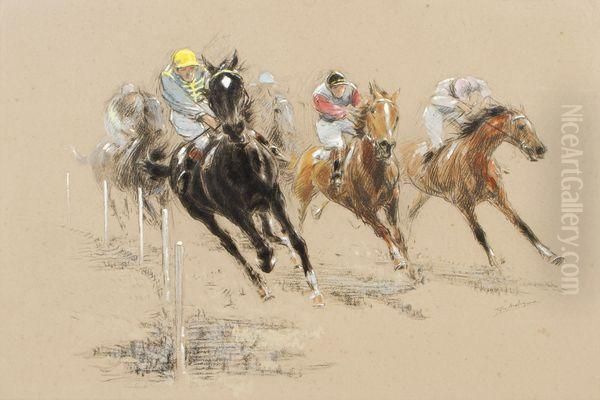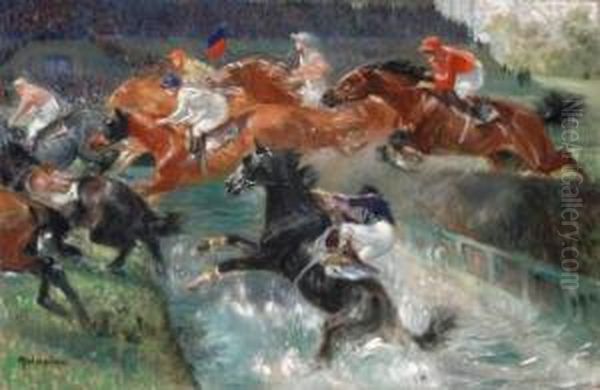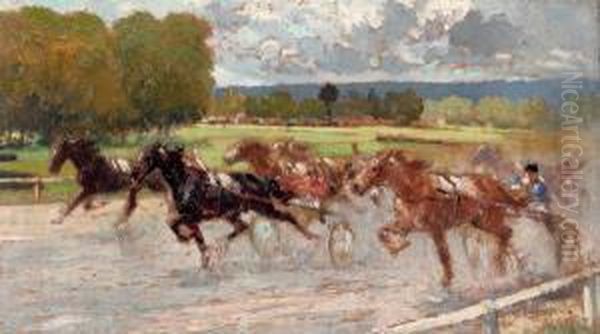Louis Ferdinand Malespina, a French artist whose life spanned from 1874 to 1940, carved a distinct niche for himself in the art world, primarily celebrated for his evocative depictions of equestrian life. His canvases breathe with the energy of horse races, the elegance of stately rides, and the dynamic thrill of the hunt. While his name might occasionally be intertwined with that of a much earlier, historically significant Italian nobleman and explorer, Alessandro Malaspina, it is crucial to distinguish Louis Ferdinand as a painter dedicated to capturing the spirit and movement of horses and their human companions. This exploration delves into the life and work of the artist Louis Ferdinand Malespina, his artistic contributions, his presence in the art market, and clarifies the separate identity of the notable explorer with whom his name is sometimes confused.
The Life and Times of an Equestrian Painter
Born in 1874, Louis Ferdinand Malespina entered a world where artistic expression was undergoing significant transformations. France, particularly Paris, was the epicenter of artistic innovation, with Impressionism having recently challenged academic traditions and Post-Impressionism beginning to explore new avenues of form and color. While detailed records of Malespina's early life and formal artistic training are not extensively documented in readily available sources, his body of work suggests a profound understanding of equine anatomy and movement, coupled with a keen eye for the social and sporting aspects of horsemanship prevalent in late 19th and early 20th-century France.
His artistic career unfolded during a period that saw continued aristocratic and bourgeois engagement with equestrian sports, from racing at Longchamp and Auteuil to leisurely hacks in the Bois de Boulogne and formal hunts. This societal fascination provided a rich tapestry of subjects for artists. Malespina's choice to specialize in this genre placed him in a lineage of painters who found inspiration in the horse, a subject that had captivated artists for centuries, from the grand battle scenes of Paolo Uccello to the romantic portrayals by Théodore Géricault and the dynamic racing scenes of Edgar Degas.

Malespina's active years coincided with the careers of numerous other artists. While direct collaborations or mentorships are not explicitly detailed, he would have been aware of contemporaries like Henri de Toulouse-Lautrec, whose depictions of Parisian nightlife often included horses in urban settings, or Edgar Degas, whose studies of racecourses and jockeys set a high bar for capturing movement and atmosphere. Earlier masters of animal and equestrian art, such as Alfred de Dreux and Rosa Bonheur, had already established a strong tradition in France, and their influence likely permeated the artistic environment in which Malespina worked. His focus remained steadfastly on the horse, rendered with an appreciation for both its raw power and its refined grace.
Artistic Style and Thematic Focus
Louis Ferdinand Malespina's artistic output is characterized by a vibrant and dynamic style, adept at conveying the speed and excitement inherent in equestrian events. He worked proficiently in several media, including oil on canvas, oil on paper, watercolor, and mixed media, often incorporating charcoal. This versatility allowed him to adapt his technique to the specific demands of his subjects, whether capturing the glossy sheen of a thoroughbred's coat in oils or the fleeting motion of a race in quicker, more fluid strokes of watercolor and charcoal.
His primary thematic focus was unequivocally the world of horses. This encompassed a range of scenarios:
Horse Racing: Many of his works depict the thrilling spectacle of horse races, capturing jockeys in colorful silks urging their mounts towards the finish line. He paid close attention to the straining muscles of the horses, the focused intensity of the riders, and the blurred energy of the track.
Steeplechasing and Hurdling: Scenes of horses and riders navigating challenging jumps, such as in "Saut de haie" (Hurdle Jump), showcase his ability to freeze a moment of peak action and tension.
Carriage Racing (Trot Attelé): Malespina also depicted the distinct discipline of harness racing, capturing the unique gait of trotters and the specific equipment involved.
Hunting Scenes: Though less frequently cited in auction records, the tradition of equestrian hunting scenes was strong, and it's plausible he explored this theme as well, given his overall dedication to equine subjects.

A consistent feature in his work is the meticulous attention to detail, particularly in the anatomy of the horses and the attire of the jockeys and riders. His compositions are often dynamic, using diagonal lines and a sense of depth to enhance the feeling of movement. His color palette could range from the rich, earthy tones of a stable or countryside to the bright, contrasting colors of jockey silks against the green of the racetrack. Artists like John Lewis Brown, a French painter of British origin known for his hunting and military scenes involving horses, or even the earlier English sporting artists like George Stubbs (though from a different era and country, his anatomical precision set a standard), represent a broader tradition that Malespina's work echoes in its dedication to the equine form.
Notable Works and Market Presence
Louis Ferdinand Malespina's paintings have maintained a consistent presence in the art market, frequently appearing at auctions, particularly in France. This sustained market activity attests to an ongoing appreciation for his skill and chosen subject matter among collectors. Several works serve as representative examples of his oeuvre:
"Vers l'arrivée, corde à droite" (Towards the Finish, Rail on the Right): An oil on paper laid down on canvas, measuring 47.5 x 61 cm. This piece, signed in the lower right, captures the intensity of a race's final moments. It has appeared at auction with estimates typically in the range of €300 to €450.
"Autenil, course de baies" (Auteuil, Race of Bays/Bay Horses): An oil on canvas, 54 x 81 cm, also signed lower right. This work, likely depicting a scene from the famous Auteuil Hippodrome in Paris, known for its steeplechase events, has commanded higher estimates, often between €3,000 and €4,000. The title suggests a focus on bay-colored horses, showcasing his attention to specific equine characteristics.
"Course de chevaux" (Horse Race): A mixed media work, employing charcoal and watercolor, measuring 40.5 x 60 cm, signed lower right. This piece demonstrates his versatility across different media and has been estimated in the €300 to €400 range. The combination of charcoal for line and structure with watercolor for tone and vibrancy is a common technique for capturing lively scenes.
"Saut de haie" (Hurdle Jump): An oil on canvas, larger at 65 x 100 cm, signed lower right. This work, focusing on the dramatic action of a steeplechase, has been estimated between €600 and €800. Such scenes allowed Malespina to showcase his skill in depicting horses in powerful, athletic poses.
"Course de trot attelé" (Harness Trot Race): An oil on canvas, 54 x 81 cm, signed lower right. This painting, depicting the specific discipline of harness racing, has seen estimates in the range of €1,500 to €2,000, indicating a solid appreciation for his portrayal of this distinct equestrian sport.
"La chute deviation" (The Fall Deviation): A signed and numbered print, 43 x 58 cm. The existence of prints suggests an effort to make his work accessible to a broader audience and indicates a certain level of popularity for his imagery.

These works have appeared at various auction houses, including Blanchet & Associés and Couton-Veyrac-Jamault, among others. The consistent sale of his paintings, often within or exceeding their estimates, points to a stable collector base interested in traditional equestrian art. While perhaps not reaching the stratospheric prices of some of his more famous contemporaries like Claude Monet or Pierre-Auguste Renoir, who explored different themes, Malespina's market performance is respectable for a specialist painter of his era. His work would appeal to those who appreciate the technical skill involved in animal painting, a field also graced by artists like Constant Troyon or the sculptor Antoine-Louis Barye, known for his animal bronzes.
Exhibitions, Recognition, and Context
While specific records of major solo exhibitions or prestigious awards won by Louis Ferdinand Malespina during his lifetime are not prominently highlighted in the available information, his regular appearance in auction catalogues serves as a form of ongoing public display and market validation. The art world of his time was multifaceted, with the official Salon system still influential, though increasingly challenged by independent exhibitions. Artists like Jean-Léon Gérôme or William-Adolphe Bouguereau represented the academic tradition that often dominated the Salons, while Malespina's work, with its focus on contemporary sporting life, might have found appreciation in circles that valued both skilled representation and engaging, modern subject matter.
There is a mention of Louis Ferdinand Malespina being involved with a project titled "Panorama du Monde Tourne" alongside the French marine painter Louis-Jules Dumont (also known as Jules Dumont). Panoramas were a popular form of entertainment and visual spectacle in the 19th and early 20th centuries, often depicting grand historical events, exotic landscapes, or city views. Malespina's role in such a project, if indeed this refers to the painter, is not detailed, but it suggests a potential engagement with larger-scale, possibly collaborative, artistic endeavors.
Furthermore, his name is listed among artists in the French military during World War I. Many artists were conscripted or volunteered during the Great War, and some were officially tasked with documenting the conflict or creating propaganda. The specific nature of Malespina's duties or artistic contributions during this period remains unclear from the provided sources, but it places him within a generation of artists whose lives and careers were impacted by this global upheaval. Other artists, such as Fernand Léger or Georges Braque, had their Cubist explorations interrupted by war service, which profoundly affected their later work.
The artistic environment in which Malespina operated was rich and varied. Beyond the Impressionists and Post-Impressionists, there were movements like Symbolism, with artists such as Gustave Moreau or Odilon Redon, and the burgeoning Fauvist movement led by Henri Matisse and André Derain in the early 20th century. While Malespina's style appears to have remained more traditional and representational, focused on his specialized subject, he would have been working in a milieu buzzing with these diverse artistic currents.
A Note on Historical Confusion: Alessandro Malaspina
It is important to address a point of potential confusion that arises from the similarity of names. The provided information, when collated, sometimes blends details pertaining to the painter Louis Ferdinand Malespina (1874-1940) with those of a significantly earlier and entirely different historical figure: Alessandro Malaspina (1754-1810). This latter Malaspina was an Italian nobleman, explorer, and navigator who undertook a major scientific and political expedition for the Spanish Crown. To ensure clarity, the key biographical details of Alessandro Malaspina are presented separately.
Alessandro Malaspina was born on November 5, 1754, in Mulazzo, Tuscany, into a noble family with ancient roots. He entered the Spanish Royal Navy and rose through the ranks, demonstrating considerable skill and intelligence. His most famous achievement was leading the Malaspina Expedition (1789-1794) aboard the corvettes Descubierta and Atrevida. This was one of the most ambitious scientific voyages of its era, aiming to chart coastlines, study natural history, conduct ethnographic research, and assess the political and economic conditions of Spanish colonies, particularly along the Pacific coasts of the Americas and across the Pacific to the Philippines and Australia.
The expedition amassed a wealth of scientific data, botanical and zoological specimens, and ethnographic observations. However, upon his return to Spain, Alessandro Malaspina became entangled in political intrigues. He was critical of Spain's colonial administration and proposed reforms, which brought him into conflict with the powerful minister Manuel Godoy and, by extension, King Charles IV. Accused of plotting against the state, Malaspina was arrested in 1795 and, after a summary trial, imprisoned in the Castle of San Antón in A Coruña, Galicia, from 1796 until 1802.
His scientific findings were largely suppressed and remained unpublished for nearly a century, a significant loss to the scientific community of the time. After his release, facilitated in part by Napoleon's influence, Malaspina was exiled from Spain and returned to Italy. He spent his final years in Pontremoli, near his birthplace, and briefly served in the government of the Napoleonic Kingdom of Italy. However, he reportedly felt politically isolated and disillusioned. Alessandro Malaspina died on April 9, 1810, suffering from intestinal illness, his immense contributions to science and exploration largely unacknowledged during his later life.
The life events, political controversies, imprisonment, scientific achievements, and specific birth and death dates (1754-1810) clearly belong to Alessandro Malaspina the explorer, not Louis Ferdinand Malespina the painter. The shared surname appears to be the source of this conflation in some records.
Legacy of Louis Ferdinand Malespina
Returning to the painter, Louis Ferdinand Malespina (1874-1940), his legacy resides in his dedicated portrayal of the equestrian world. His works offer a vibrant window into the sporting and social culture of his time, celebrated through the grace, power, and dynamism of the horse. While he may not have been a revolutionary figure in the grand narrative of art history like Pablo Picasso or Wassily Kandinsky, who were his contemporaries and were forging entirely new visual languages, Malespina excelled within his chosen genre.
His paintings continue to find an appreciative audience, particularly among enthusiasts of equestrian art and collectors of early 20th-century French painting. His ability to capture the thrill of the race, the elegance of the ride, and the specific character of different equestrian disciplines ensures his enduring appeal. The consistent presence of his works in the art market is a testament to this. He contributed to a long and distinguished tradition of animal and sporting art, a field that requires not only artistic skill but also a deep understanding of the animal subject.
In conclusion, Louis Ferdinand Malespina was a talented French artist who devoted his career to the depiction of horses and equestrian activities. His paintings, characterized by their dynamism, detail, and vibrant energy, offer a valuable visual record of this aspect of early 20th-century life. It is essential to distinguish him from the explorer Alessandro Malaspina, a significant historical figure from an earlier era, to appreciate fully the distinct contributions of Louis Ferdinand Malespina to the world of art. His work stands as a fine example of specialized genre painting, capturing a timeless fascination with one of humanity's noblest animal companions.